Vol 1 No. 17 TROPIC LIGHTNING NEWS June 24, 1966
Index
[The 1966 Vietnam issues of Tropic Lightning News were published in Saigon,
and are of lower quality than later years that were printed in Japan. Over
the years the photographs and text have faded and it has been difficult to
reproduce them. Even when the photos are unclear, I have been included
them to give a sense of the activities in the Division.]
Old Form Obsolete
New Ration Card Issued To All Troops July 1
A new ration card becomes effective July 1, replacing the old, pink card,
which will be obsolete.
The new card will entitle the holder to purchase rationed items and a limited
number of items costing more than $10.
The new form, consisting of three parts, must be intact. Any portion
separated from the center section voids the entire card. All rationed exchange
merchandise is non-transferable.
If a card is lost or stolen the individual must report it in writing to the
nearest provost marshal through his unit ration card control officer, who will
issue the cards.
Although the new card is not effective until July 1, it has been valid since
April 15 and issued to new arrivals in Vietnam.
Persons rotating on or before June 30 will not be issued new cards but those
whose tour of duty extends past that date will be issued a new card and must
turn the old one in to the issuing officer.
All controlled or rationed items on the pink card will be recorded on the new
one before it is turned in. Persons in isolated areas, who wish to have one man
purchase items for a group, must have a written statement from their commanding
officer, including the name, rank and service number of the purchaser as well as
of those for whom he is buying the items.
77 AVIATION MEN DECORATED WITH AIR MEDALS
Seventy-seven members of 25th Aviation Battalion were decorated last week in
a mass awards ceremony at Cu Chi. The men all received Air Medals for aerial
missions against the Viet Cong.
Major General Fred C. Weyand, division commander, congratulated each of the
men as he presented the medals.
In his brief speech after the presentation, General Weyand emphasized the
aviation battalion’s part in enabling the division to “Strike anywhere,
anytime.” The general praised the men, as he said, “for the capability you
gentlemen have brought to the division.”
The awards were presented to 77 pilots, crew chiefs and gunners of the
battalion for flying at least 255 combat operational missions over hostile
territory in direct support of ground forces.
|
1/27th Greets Lt. Col. O’Neal As Commander Lieutenant Colonel Alvin L. O’Neal, of Houston, Tex., has assumed command of the 1st Battalion, 27th Infantry (Wolfhounds). He replaces Lieutenant Colonel Harley Mooney, who has become assistant chief of staff, G-2. At change of command ceremonies, the 40-year-old officer talked to the men of the unit, saying, “I couldn’t be prouder if I’d written the orders myself to join the ‘Wolfhounds’ who fought communism 40 years ago.” He added, “It’s kind of ironic that we have to join together and lose some of our individual liberty to gain what we’re fighting for.” Colonel O’Neal holds a bachelor of science degree in history from the University of Omaha. The 1/27th Inf. is one of three maneuver battalions in the 2nd Brigade. |
General Collins Inspects Cu Chi ARC Facilities
General (retired) James F. Collins, president of the American Red Cross
(ARC), visited the division last week as part of an orientation tour of United
States bases in Southeast Asia. The purpose of the trip was to determine what
new Red Cross facilities were needed in the Vietnam combat areas.
General Collins, former commander-in-chief, U.S. Army, Pacific, was met at
the Cu Chi Army Airfield by Major General Fred C. Weyand, division commander,
Brigadier General Edward H. de Saussure, assistant division commander, and
Division Chief of Staff Colonel Thomas W. Mellen.
The group went to division headquarters, where they were joined by other Cu
Chi-based Red Cross personnel to discuss ARC activities in the area.
The 25th Division Red Cross Office handles more than 650 new cases every
month, including emergency leave cases, requests for health and welfare reports
on families and service personnel and miscellaneous family and personal
problems.
The first of a team of six Red Cross girls is expected to arrive at Cu Chi by
the end of this month. They will take over the new enlisted men’s club,
bringing the total number of Red Cross workers with the division to ten.
Division Gives Orphans $5,000
More than $5,000 has been contributed to the support of the Dong Ngai
Orphanage from the 25th Infantry Division, according to Major William W. Walker, assistant
division civil affairs officer.
Contributions for the project, sponsored by II Field Force, Vietnam, were
made during payday and Sunday religious service donations.
It is the second orphanage the division is sponsoring officially, joining the
longstanding association of 1st and 2nd Battalions, 27th Infantry, and 1st
Battalion, 8th Artillery, with the Holy Family Home, Osaka, Japan.
Viet Leader Visits Div.
Lieutenant General Nguyen Van Thieu, chairman of the National Leadership
Committee of the Republic of Vietnam, visited the division base camp last week.
After receiving a tactical briefing from Major General Fred C. Weyand, the
division commander, General Thieu was presented a commemorative plaque by
General Weyand.
The plaque, pledging “our continued assistance in the cause of freedom,” also
carried the words, “This plaque symbolizes the deep respect of the men of the
25th U.S. Infantry Division for the people of the Republic of Vietnam.”
General Thieu responded with gifts of his own to General Weyand, Brigadier
General Edward H. de Saussure, assistant division commander, and all the major
unit commanders of the division.
| GOVERNMENT VISITOR – Major General Fred C. Weyand, division commander, greets General Nguyen Van Thieu, chairman of the National Leadership Committee of the Republic of Vietnam, at the Cu Chi Army Airfield. (Photo by Park) |
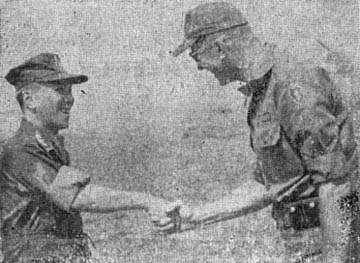 |
25th’s 25th
Yearbook Sale Announced
The colorful 25-year history of the 25th Infantry Division will be depicted
in a 400-page pictorial review book to be published on Oct. 1, 1966, the
division’s silver anniversary.
Announcement of the anniversary and the publication commemorating the
occasion was made by Major General Fred C. Weyand, division commander.
Highlights will include a color section of the division’s military operations
in Vietnam, action pictures of the division in World War II and Korea,
anniversary messages and sections on the preparation and training of the
division at Schofield Barracks in jungle and guerrilla warfare, unit activities
during the last 25 years and special features of the division’s commitments in
Vietnam.
The theme of the book is “The 25th’s 25th . . . in Combat.” More than 1,000
pictures taken over the last 25 years have been selected by the yearbook staff
to illustrate the “dedication, determination and courage” of the combat
division, which is one of two in the United States Army authorized to wear the
Combat Infantryman’s Badge with two stars because of its participation in three
combat zones.
Major William C. Shepard, of San Antonio, Tex., division information officer,
outlined the purpose of the book when he said:
“To capture two and one-half decades of a determined effort to promote and
preserve peace, build the nation’s defenses and deter enemy aggression within
the short span of 400 pages, the book will portray division activities from its
baptism of fire at the start of World War II through its present military
operations in Vietnam.”
Editor of the book is Specialist Four R. Vincent Puchalski, of Scranton, Pa.,
and officer-in-charge is 2nd Lieutenant Patrick J. McKeand, of Anderson, Ind.
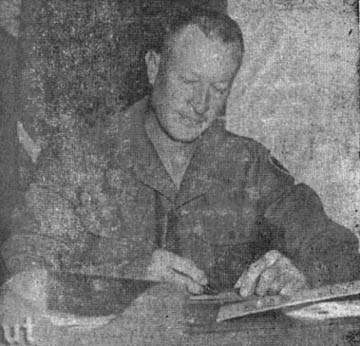 |
YEARBOOK ORDER - Major General Fred C Weyand, division commander, signs the first order card for the division Yearbook which will commemorate the “Tropic Lightning” 25th anniversary on Oct. 1, 1966. |
Page 2 TROPIC LIGHTNING NEWS June 24, 1966
Decorated
| BRONZE STAR MEDAL (With "V" Device) | |
|
PSgt. James M. Deacon, Co. B, 2nd Bn., 27th Inf. 2nd Lt. Robert D. Duffle, Co. A. 2nd Bn., 27th Inf. Sp4 Valle Encarnacaon-Del, Co. A, 2nd Bn., 27th Inf. Sp4 Lawrence P. Hall, HHC, 2nd Bn., 14th Inf. SSgt. Marion J. Kruq, Co. B, 2nd. Bn., 27th Inf. Sp4 Charles C. London Jr., HHC, 1st Bn, 69th Armor |
MSgt. Joseph T. Kacala, HHC, 65th Engr. Bn. Lt. Robert M. Pfeiffer, 30th Weather Squadron Sp4 Andres Ramirez, Co. C, 2nd Bn., 27th Inf. Sp5 Francisco Ramirez-Medina, HHC, 2nd Bn., 27th Inf. Sp4 Anibal Sonera-Gonzalez, Co. B, 2nd Bn., 27th Inf. MSgt. Charles L. Vanover, Trp. A, 3rd Sqdn., 4th Cav. |
| AIR MEDAL |
|
|
Maj. Anthony J. Adessa, Co. B, 25th Avn Bn. Lt. Col. Boyd T. Bashore, HHC, 2nd Bn., 27th Inf. Maj. Robert W. Blake, Co. A, 25th Avn. Bn. Maj. Robert D. Bretz, Co. A, 25th Avn. Bn. |
Maj. Lewellyn A. Brown, Co. A, 25th Avn. Bn. Maj. Raymond F. Huntington. Co. A, 25th Avn. Bn. Maj. James E. Miller, Co. B, 25th Avn. Bn. Maj. Keith J. Rynott, Co. A, 25th Avn. Bn. |
| ARMY COMMENDATION MEDAL |
|
| SSgt. Edward A. Lillard, HHC, 2nd Bde. | |
| PURPLE HEART |
|
|
2Lt. Gerald R. Abbott, Co. C, 1st Bn., 5th Inf, PFC Calvin Allen, Co. A, 2nd Bn., 27th Inf. PFC Emmitt Allen, Co. B, 4th Bn., 23rd Inf. SP5 Thomas G. Allen, HHC, 4th Bn., 9th Inf. Sp4 William E. Arthur, Co. C, 4th Bn., 23rd Inf. Sp4 Johnny L. Atwater, Co. C, 4th Bn., 23rd Inf. |
PFC Dennis Bailey, Co. B, 4th Bn., 9th Inf. Sp4 Craig A. Berwald, Co. A, 2nd Bn., 27th Inf. Sp4 B. J. Bradford, Co. A, 2nd Bn., 14th Inf. Sgt. Philip W. Bridges, Co. A, 2nd Bn., 14th Inf. Sp5 Machon D. Broxie, HHC, 4th Bn., 23rd Inf. PFC Alan R. Brunt, HHC, 2nd Bn., 14th Inf. |
Direct Control
Hanoi Pulls Strings On All VC Efforts
The Communist regime in Hanoi directs, controls and supplies the entire Viet
Cong political and military effort to conquer the Republic of Vietnam.
All control - political and military - comes ultimately from the Central
Committee of North Vietnam’s Lao Dong Party, which maps out broad strategy. The
Reunification “Commission of the Northern government controls the National Front
for the Liberation of South Vietnam, and the Military High Command in the North
is responsible for the military training of the men who infiltrate into the
South. In addition, a central intelligence organization In Hanoi - the Central
Research Agency - maintains an elaborate intelligence network in South Vietnam
and directs the extensive undercover activities of the Viet Cong.
The two communist administrative headquarters to the South, inherited from
the Viet Minh, have been merged into the Central Office for South Vietnam. This
central “brain” coordinates all communist party activity in the South and all
relations with the highest Communist Party and government echelons in North
Vietnam.
In South Vietnam, the communists have created a show of legitimacy through
the National Front for the Liberation of South Vietnam. At the national
headquarters level, the Front has a central committee and presidium, which take
their orders from the control committee of the People’s Revolutionary Party - the Communist Party in South
Vietnam.
The Front’s National Central Committee sets policy and also is responsible
for planning and organization building. The next level in the Front hierarchy
consists of the three interzone headquarters, which determine agitprop
(persuasion and propaganda) policy guidance and which are responsible for
political indoctrination and training. Under the interzone headquarters are
seven zone headquarters, which are their sub-offices.
Next in the Front’s structure are the approximately 30 provincial committees
- its chief operating units. These committees direct the “liberation
associations” the communists use to spread their indoctrination and propaganda
and to gain the often-unwitting support of the South Vietnamese people. The
committees, of course, also transmit to subordinate levels the orders sent down
from the central committee. In addition - and this is a major role at the
provincial level - they assign military duties to the Viet Cong units operating
in their provinces.
The Front’s committees and cells in South Vietnam’s districts, towns and
villages make up the largest part of the Communist spider web. In the Viet
Cong-dominated areas of South Vietnam, they are in the open, free of government
interference as they carry out their so-called political struggle, recruit and
train men for their local Viet Cong units and carry out the military or
guerrilla tasks they are assigned.
In the areas controlled by the legitimate government, of course, the
communists and grass-level front members must remain under cover and work in
secret in their efforts to overthrow the government of the Republic of Vietnam.
Since the communists are using the National Liberation Front to camouflage
their anti-government activities, their People’s Revolutionary Party
organization parallels the Front structure, and that Communist apparatus keeps a
tight control on the Front from the top-level central committee to at least the
provincial level.
(Next week: How the military effort fits in.)
Another Ilikai Debuts
Ribbon-cutting ceremonies were held recently opening the “Ilikai East,” a new
service club for division soldiers at Cu Chi.
Major General Fred C. Weyand, division commander, was on hand to snip the
ribbon, officially opening the new club. Between field operations, division
troops will be able to enjoy the club’s many recreational facilities, which
include television, ping-pong, billiards, darts, horseshoes and volleyball. For
those who wish to relax, the club offers books, magazines, card rooms and a wide
variety of music.
Along with the assortment of food and soft drinks sold, there will be candy,
cookies, cake, cigarettes and many other such items given to the troops without
cost. These items are donated by thoughtful Americans.
To the rear of the club is the new PX beer garden spread out under the trees,
and specially thatch-roofed patios. Lieutenant Miguel Camacho, of San Juan, P.
R., will act as the club officer, while the duties of custodian will be
accomplished by Sergeant First Class Edward J. Deal, of Niagara Falls, N.Y.
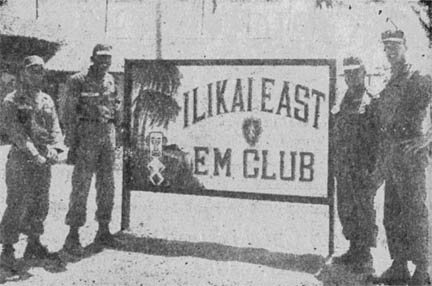 |
| Major General Fred C. Weyand (r) stands by the sign of the division’s new service club. With him are (from left) Lieutenant Miguel A. Camacho, club officer, Captain Frederick C. Turner Jr., division Special Services officer, and Sergeant First Class Edward J. Deal, the club custodian. (Photo by Pardue) |
‘Chieu Hoi’ – Open-Arms Program
“Chieu hoi” is the Vietnamese expression for open arms and it means a
handshake, hot food and an offer to return to a better life at the hands of the
Vietnamese government.
Inspired by communist defectors and the fact that many Viet Cong come from
everyday Vietnam life, the Chieu Hoi Program is designed to encourage guerrillas
to abandon their fight against the central government.
But it is more than just an arm established to encourage enemy defection.
Entailing indoctrination to combat communist propaganda, Chieu Hoi furnishes
intelligence, serves to weaken the Viet Cong while strengthening the government
and is thought to cause dissension and distrust within VC ranks.
Chieu Hoi at the national, regional and provincial levels is organized into
the Chieu Hoi Action Plan, which includes construction, maintenance and repair
of one national, five regional and 39 provincial centers for the reception and.
rehabilitation of returnees.
The centers provide returnees with a place to live while the government
supplies them vocational training to permit them to take their places as useful
parts of Vietnamese society. For the many displaced returnees, the center also
provides a resettlement plan to help returnees move quietly back into native
life. When the “graduates” leave the centers, they are further helped with
moderate sums of money.
The program also tries to enlist the help of returnees in existing government
intelligence and propaganda activities.
The volunteers, organized into Chieu Hoi Armed Propaganda Units, move among
the people in villages and hamlets to explain the policies and aims of the
government and the Chieu Hoi Program and to encourage Viet Cong defection.
The government began the armed propaganda units hoping that returnees could
explain the differences between the two political systems more effectively than
others.
In encouraging VC defection, the government tells the Viet Cong that they are
welcome under the Chieu Hoi Program, and they can expect good treatment and the
chance to return to their families. Chieu Hoi units also observe that the
government and Free World Military Assistance Forces are winning the war, making
continued resistance futile.
The entire Chieu Hoi effort is aimed at VC military forces, Viet Cong
civilian sympathizers and workers, families of active VC, inhabitants of
communist-controlled areas and at the national population of Vietnam.
The open-arms policy is reaping benefits. So far in the provincial program
in 1966, Chieu Hoi has welcomed over 13,000 returnees in its centers.
| The TROPIC LIGHTNING NEWS is an
authorized publication of the 25th Infantry Division. It is published
weekly for all division units in the Republic of Vietnam by the
Information Office, 25th Infantry Division, APO U.S. Forces 96225. Army
News Features, Army Photo Features and Armed Forces Press Service material
are used. Views and opinions expressed are not necessarily those of the
Department of the Army. Printed in Saigon, Vietnam, by Dai Doan Ket
Publishing Company. Maj. Gen. Fred C. Weyand . . . . Commanding General Maj. William C. Shepard . . . . . . Information Officer 2nd Lt. Patrick J. McKeand . . . Officer-in-Charge Sp5 Dale P. Kemery . . . . . . . . . Editor PFC David L. Kleinberg . . . . . . Editorial Assistant |
Page 3 TROPIC LIGHTNING NEWS June 24, 1966
20-Minute Tale
“Hair-Raising” Ambush Kills Eight Viet Cong
It, was 8:10 p.m. and Sergeant Carlos Encarnacion, 19, Rio Granda, P.R., was
leading his eight-man ambush patrol 700 yards beyond the 2nd Battalion, 27th
Infantry, perimeter.
At 8:30 on the dark, moonless night, the ambush was over and the men were
returning to the base camp.
What happened in the intervening twenty minutes is a hair-raising tale.
“We picked the spot with a lake to our front and set out four Claymores on
the other side of the berms in the paddy,” said Encarnacion.
“I put my machine gunner on the corner of the L-shaped ambush so he could
cover both sides.”
“We weren’t there five minutes when a flare went off from the base camp and
we all hit the ground,” continued the squad leader, who received the Bronze Star
Medal for valor on another division operation.
When the squad got up the excitement began. Specialist Four Manuel Flores,
20, of East Los Angeles, Calif., the machine gunner, looked over the berm and
saw 12 Viet Cong moving into the “Wolfhound” position.
“They were so close,” said Flores, “that I had to give the warning ‘VC!’ in a
whisper. Our Claymores were no good because the VC already were between us and
the mines. The only thing I could do,” continued Flores, “was stand up and fire
a 200-round burst . . . the whole can of ammo. The first VC fell about three
feet from me,”
The ambush squad, alerted by Flores’ whispered warning, began to withdraw,
still firing at the enemy.
In the midst of the shooting, a rifle grenade landed on the berm in front of
Flores.
“It rolled to the other side and went off. I guess I was lucky. It just
grazed my cheek and burned my elbow,” said Flores.
Since no VC were standing when the grenade came in, the men figured it was
fired as an enemy soldier was hit by a barrage of machine gun bullets. Two
other men were nicked by grenade fragments.
The following morning, eight bodies were found along with four weapons, two
of which were fitted with rifle grenade adapters.
SSgt James Cox Blows Bugle; Cu Chi Jumps
Gabriel may have the edge when it comes to trumpets, but when it comes to
bugles, 4th Battalion, 9th Infantry, has it hands down.
Staff Sergeant James A. Cox, the Al Hirt of the Cu Chi bugle set, is the
early bird with a horn, cracking the dawn with the sound of reveille. When Cox
puts his lips to the mouthpiece of his bugle and lets wail, 1,600 pairs of feet
thump to the floor and have their owners standing in formation almost before the
end of the call.
Besides reveille, Cox has some other numbers in his repertoire of great bugle
calls, such as mess call, assembly, taps – and a little Dixieland jazz thrown in
for flavoring.
When Cox isn’t blowing bugle, he’s section chief for the “Manchus” ground
surveillance platoon.
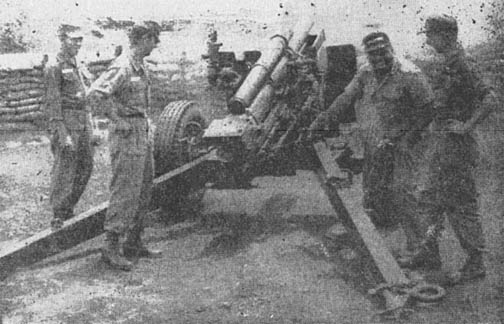 |
| BIG PUNCH - Archie Moore, former world light heavyweight boxing champion, fires a 105mm howitzer of Battery A, 2nd Battalion, 9th Artillery, during his visit to 3rd Brigade. At Moore’s right is Major Paul E. Lenhart, executive officer of the “Mighty Ninth.” (Photo by Sutphin) |
One-Round Tour
Archie Moore Hits Third Brigade
The “Broncos” of 3rd Brigade had a ringside seat for a visit last week by
former world light heavyweight champion Archie Moore.
After a briefing on the brigade’s Operation “Paul Revere,” the former
champion, who visited division headquarters at Cu Chi week before last, was
given a guided tour of the rear base camp by Major Paul E. Lenhart, executive
officer of the 2nd Battalion, 9th Artillery, and Major Quitman M. Wright, escort
officer for U.S. Military Assistance Command, Vietnam.
A highlight of the tour came when Moore visited Battery A, 2nd Battalion, 9th
Artillery, where he fired two 105mm howitzer rounds into hostile territory.
Afterwards he visited the brigade mess area, touring both the officers and
enlisted mess halls. Moore later visited Company C, 2nd Battalion, 35th
Infantry, where he was welcomed by Captain Robert Ord, the company commander.
Accompanied by Capt. Ord, the boxer toured the mess area and a fire direction
control bunker.
Following that he toured Company A and the 3rd Support Battalion
(Provisional).
After the tour of the base camp, Moore, accompanied by Maj. Wright and
Sergeant Major Norman Dube went to the base camp of 6th Battalion, 14th
Artillery. He later returned to II Corps headquarters at Pleiku.
Moore’s visit to the “Bronco” Brigade base camp was part of a four-week
personal appearance tour of military installations throughout Vietnam.
|
Rivers Honored
|
It’s Insane to Knock Batman
Batman, who until recently had gone unrecorded through 2,000 years of
Vietnamese history, has finally made it big at Cu Chi.
After speeding to overnight success in their Batmobile, Batman and his
precocious pal Robin have slowly infiltrated into almost every American base in
Vietnam, although Batman and everything that follows in his path arrived
belatedly at Cu Chi.
Many division members had long since left Hawaii before Batman made his first
daring save, but through the media of radio and printed matter he wasn’t far
away.
When replacements came to Cu Chi months later, they were often asked about
Batman. More than talk about it, some have put Batman into “practical” use.
Captain Melvin A. Casberg, Jr., Belmont Shores, California, surgeon for
Headquarters and Headquarters Company, 25th Division, uses the Bat signal when
he needs aid - and gets results.
Capt. Casberg used styrofoam to mount the beaming Batman signal in one of his
ophthalmoscopes, an instrument normally used for viewing the interior of the
eye.
“I use it for calling the medics when I need some help,” he says. “And it
works. I’ve got the craziest bunch of medics in the division. They love it.”
In the enlisted men’s club of the 25th Administration Company, a bumper
sticker sign hangs from the wall. It says “Send Batman to Vietnam.”
“I think it’s a good idea,” one private said. “They ought to bring him
here. It would be good for morale. Especially to know you have someone on your
side that can’t be beat.”
Captain Frank Jones, of Hereford, Tex., who, as division psychiatrist, is
directly concerned with the troops’ mental state of health, finds nothing wrong
with mixing Batman and war.
“Batman is the sort of thing that the men here can share with the people back
home,” he said. “It probably helps to bring some semblance of home here.”
“Having an invincible hero on your side serves to increase your own courage
and morale.”
At Cu Chi, it is almost insane to knock the Bat.
Rat Problems!!!? Try New, Instant ‘Snake’
Attention, Mr. Hooch Dweller! Having problems with rats in your room? The
one-strike service of Thompson’s Rat Ridders can save you the embarrassment of
scurrying rodents when friends come to call.
If you’ve been badgered by gray-haired things that go bump in the night, PFC
Dennis R. Thompson can probably help you sleep quietly once again. Thompson’s
Rat Ridders, located at Headquarters and Service Battery, 2nd Battalion, 9th
Artillery, has devised a sure-fire way to put those creatures in their place.
Now, through the magic of modern, Vietnam jungle technology, you will be
visited by one of our experts who knows instinctively how to make those
unpleasant rats and mice extinct. Just one call to Thompson’s Rat Ridders will
bring “Snake” rushing to your side.
“Snake” is a five-foot long rat snake who stands ready at any hoar of day or
night to wage war against your unwanted visitors. Highly trained and skillfully
polished at his profession, “Snake” can provide you with the same service many
other satisfied customers have experienced. In one two-day period alone,
“Snake” has eliminated seven of the midnight marauders.
“Snakes talents were enlisted during Operation “Paul Revere” and he now
offers “Broncos” surefire extermination service.
Remember, too, in dealing with Thompson’s Rat Ridders, you are being serviced
by a reliable firm. Proprietor Dennis Thompson has had years of experience with
exterminators of “Snake’s” proficiency, having wrapped garter snakes around the
handle bars of his bicycle while still living in his native Baltimore, Md.
And remember, Thompson’s Rat Ridders is never one to sit on past
accomplishments. Under a recently announced expansion program, Thompson’s is
planning to add a king cobra to its death-dealing staff of exterminators.
So for a quick kill, contact Thompson’s, serving 3rd Bde. for over two
weeks. Remember, your satisfaction is guaranteed or double your rats back.
Page 4 TROPIC LIGHTNING NEWS June 24, 1966
OPERATION “PAUL REVERE”
( The start of this story was lost in the center binding of the
library binding holding
it.)
...though some foxholes still had two to three feet of water in them from earlier
heavy rains.
Shortly past one o’clock the following morning, Co. A began receiving heavy
fire. This was followed by an attack of screaming, shouting North Vietnamese.
The enemy charged, withdrew, and charged again. Each assault was accompanied by
blood-curdling yells. Each attack was repulsed by the American defenders.
The enemy tried many tricks to entice the Americans to surrender or get them
to give away their positions. One enemy was heard to shout in excellent
English, “You have two and a half hours to surrender.”
Occasionally, the enemy used the ruse of yelling “Medic, medic!” in an effort
to trap unsuspecting Americans. Also, they would shout “Cease fire, cease
fire!,” then try to get into better positions. “The tricks usually bought the
speaker a one-way ticket to eternity.”
Battery A, 2nd Battalion, 9th Artillery, was supporting the operation from
another area. While firing missions during the darkness early one morning, they
came, under attack from small arms and mortar. Throughout this attack on their
own area, the artillerymen continued to support
the infantry troops in LZ 10 Alpha.
At daybreak, patrols were sent to check the area. The 3rd Platoon of A Co.
was pinned down by enemy fire. As the company’s 2nd Platoon was en route to aid
the trapped platoon, they ran into a North Vietnamese patrol heading in the
opposite direction. The ensuing firefight routed the enemy, permitting the
relief column to continue. The 2nd Platoon attacked the flank of the enemy
force, which had pinned down 3rd Platoon. The assault freed the 3rd Platoon and
killed 15 of the enemy.
Eight men and the platoon leader of the 2nd Platoon remained behind to bring
back the wounded. As they were returning to friendly positions they saw about
50 screaming North Vietnamese attacking American positions.
Unable to reach the perimeter, they set up their own defenses and laid fire
on the attacking force. The action pinned down two enemy mortar crews and
killed at least 40 of the NVA troops.
During the morning, helicopters continually brought in much-needed supplies
and, along with the Air Force, provided air firepower.
Although the rest of the 1st Battalion, 35th Infantry, was eventually brought
into the area, the big battle was over. The fighting in LZ 10 Alpha accounted
for 178 enemy killed by body count. Since the operation began May 10, 435 enemy
wave been killed. One hundred forty six small arms and eight crew-served
weapons have been captured. American casualties remain light.
|
3rd Brigade |
| HACKING – Troops of Company C, 1st Battalion, 14th Infantry, cut their own trail through the central highlands on combat patrol during “Paul Revere.” |
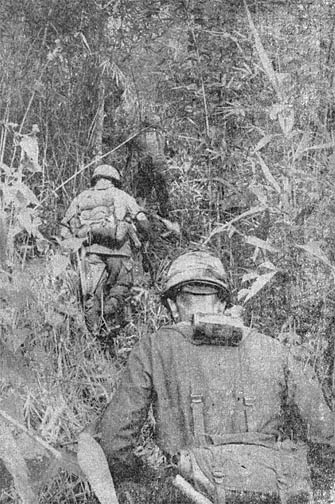 |
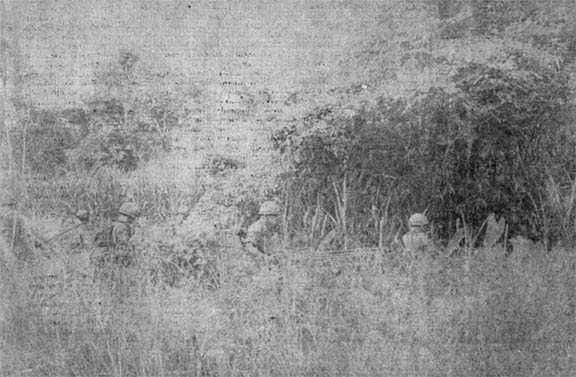 |
| PUSHING THROUGH – The grass is tall and the hedgerows thick as members of Company C, 1st Battalion, 14th Infantry, wade through the jungle during Operation “Paul Revere.” |
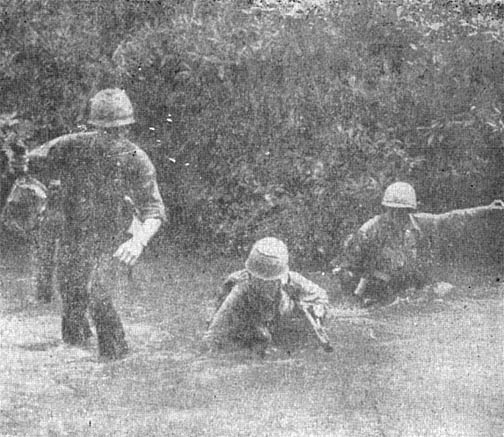 |
UNREQUESTED BATH – Out of the jungle and into the drink. The men from 1st Battalion, 14th Infantry, push across a stream southwest of Pleiku. |
| RESCUE – It’s called “Dustoff” as members of Company B, 25th Medical Battalion, take a casualty from an ambulance to the forward hospital. |
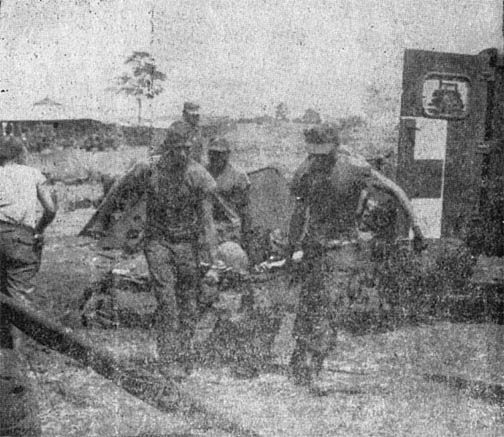 |
Page 6 TROPIC LIGHTNING NEWS June 24, 1966
R&R: Just Five Beautiful Days
“I hate to tell you this,” the PFC announced over his loud speaker, “but
there’s been another delay and we won’t be ready to board for another hour.”
The division soldiers, all patiently awaiting their rest and recuperation
flight to Tokyo, filtered off in different directions, some muttering
profanities, others accepting their fate silently.
The terminal in Saigon was hot and muggy. All the men wanted to do was get
aboard the plane and forget the war and suffering for five days.
But the giant, 727 Pan American bird was late. Then it was there, moving in
almost like a taxi.
One by one, the soldiers climbed aboard, exchanging the heat of Vietnam for
the Plane’s air conditioning.
One stewardess greeted the men at the door. She was pretty. She was very
pretty. In fact, she was about the most beautiful thing most of the men had
seen in months. Her name was Linda. She had blonde hair. That was beautiful.
Her eyes were blue. They were beautiful too. She had on a blue skirt and white
blouse. Beautiful!
“Gentlemen,” Joanne, another stewardess, announced, “There are some seats in
the rear.”
“Gentlemen?!?” someone questioned. “You don’t have to call us gentlemen.
Just say, ‘move out’.” The men, meanwhile, moved into their seats.
“Is that Linda?” someone asked.
“I don’t know. Does it matter?” came the reply.
Luana, the third stewardess, gave the procedural announcements, the location
of the lavatories (she didn’t call them latrines), the location of the emergency
exits, etc. “And,” she concluded, “If there’s anything else I can do for you
just yell.”
Roughly 123 of the 123 passengers felt like yelling, possibly screaming but
there was silence, except for the engines, which were beginning to warm up.
The pilot announced, “We’ll be flying at about 29,000 feet and expect no
weather difficulties en route. We hope you have a good flight.”
And so the jet roared off into the fading daylight. One stewardess pressed
her tiny nose against one of the windows to catch a glimpse of Saigon below. As
someone remarked, that’s about the safest place to see Saigon from.
A few hours later the super jet stopped over for an hour at Taipei, Formosa.
As the jet landed, some guys still hadn’t realized that Vietnam was many miles
away.
One said, “Let’s form a perimeter around the plane, dig foxholes, set up trip
flares and booby traps. We’ll have 50 per cent (guard).”
“Ha!” his friend replied. “You pull my 50 per cent.”
Long before even one foxhole could have been dug, the jet was on its way and
soon in Japan.
It would be great - for five days at least.
PFC Destroys Enemy Position On Perfect Call
PFC Russell L. Crawford, Patterson, Calif., a radio operator for Company A,
1st Battalion, 35th infantry, could hear the enemy mortar fire but he didn’t
have a map or a compass.
He called in fire on the enemy position anyway.
During the 3rd Brigade’s Operation “Paul Revere” near Pleiku, Crawford and
other members of the third platoon were returning to the company’s position
after gathering an armful of enemy weapons in the jungle.
He saw a puff of smoke and heard a loud noise as a North Vietnamese Army (NVA)
mortar dropped on the landing zone (LZ), which was also the company’s location.
He called the company 81mm mortar section and had them fire a round into the
center of the platoon’s sector. He adjusted their fire from that.
Hot Food in the Field
’Flying Cooks’ KO C-Rations
Specialist Four Lynn J. Woodard, of St. Clair, Mich., is a “flying cook,” one
of a unique group of men who air lift at least one hot meal a day to companies
in the field on operations.
Woodard, a cook for 1st Battalion, 35th Infantry, is now catering for 3rd
Brigade’s Operation “Paul Revere.”
There are no cooking facilities in the field, so food must be prepared at the
rear area base camp and air lifted to the men. This is the occupation of the
‘flying cooks’ and to the man who must face a diet of C-rations, the ‘flying
cooks’ are a welcome sight.
Each morning the cooks take the empty insulated containers from the command
post and load them on to helicopters to be taken to the battalion’s rear
location.
“At the rear command post we have a consolidated mess hall,” Woodard said.
“Once I get there with the empty, dirty equipment the KPs wash the cans.”
By this time, the hot food is usually ready. It’s loaded into the containers
and tagged to insure that each container gets to the right unit.
The men of the “Cacti Green” don’t miss their sweets either. Woodard hustles
to the bakery and checks to make sure each company gets its share including
anything from donuts to cakes.
After everything is gathered together, the food and utensils are taken to the
helipad, loaded and flown to the forward command post.
“It may sound as if there isn’t much to it,” Specialist Woodard said. “But
there have been times when I’ve gotten into some ticklish predicaments.”
“One time the company I was to feed that night was supposed to be heli-lifted
into a new position.”
He was notified by the logistics officer that he was to hit the landing zone
before his company, even though a platoon from another company was there and
supposedly had the area secure.
“When I got to the landing zone,” he said, “I saw the platoon just getting
there. If I’d been there five minutes earlier, I would have been all by myself
on a hot landing zone.”
Light Contact, Then VC Hit Third Brigade
After several weeks of light contact, elements of 3rd Brigade suddenly found
themselves in a pitched battle with a North Vietnamese Army (NVA) regiment last
week southwest of Pleiku.
During the action, the 2nd Platoon of Company A, 1st Battalion, 35th Infantry
was trying to push back an NVA attack on the east edge of a landing zone.
As the men swept the area, they were picked at by snipers hidden throughout
the heavily wooded area surrounding the landing zone.
“We didn’t know where the snipers were,” said Specialist Four Kenneth R.
Harpold of Indianapolis, Ind., a fire team leader in the 2nd Platoon.
“There was one sniper that particularly bothered us.” Harpold continued. “We
began looking for him.”
“PFC James Hyatt, who was right behind me, had a Chinese submachine gun he
had captured and I had a 12-gauge shotgun. We both opened fire on the sniper.”
“But he didn’t fall like we expected him to do. It turned out that he was
tied to the tree. We left him up there, planning to come back later and cut him
down. When we did come back to get him he was gone. Apparently, some of the
other NVA soldiers had come and taken him away,” Harpold remarked of the enemy’s
passion for conducting combat police calls.”
| REMOTE CHOW - Specialist Four Lynn J. Woodard, a “flying cook” of the 1st Battalion, 35th Infantry “Cacti Green,” stacks some insulated containers prior to loading them onto a helicopter on Operation “Paul Revere.” (Photo by Blue) |
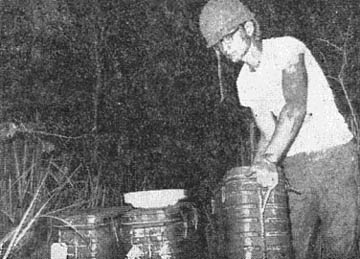 |
ARVN Could Use Digit Dialing
U.S. artillery, helicopter and jets couldn’t get the job done, so Army,
Republic of Vietnam (ARVN) called on its own air force recently to strafe a Viet
Cong target.
That’s the simple way to tell it.
Actually, ARVN called U.S. artillery. Answer No. ARVN called U.S.
helicopter. Answer: No. ARVN ALO called U. S. FAC. Answer: No. ARVN ALO
called RVNAF. FAC told ALO he Saw 10 VC dead. ARVN ALO relayed info to Center.
And when the smoke had cleared, about the only telephone not involved in the
complex air strike was undoubtedly the “hot line.”
CSCC, the Combat Support Coordination Center, the important abbreviation to
remember, is a temporary organization used only when U.S. and Republic of
Vietnam units are on large, joint operations.
Whenever such operations take place, American and Vietnamese controllers work
together to plan battle action.
During the episode described above, a Viet Cong platoon was reported 30 miles
south of the division’s Cu Chi base camp.
American artillery was too far away, American helicopters were on another
mission and U.S. planes also were too far away. But ARVN was able to find three
RVN Skyraiders to hit the position twice, followed by a third run by U.S.
F-100s, by this time in the area.
Although it may have taken a few phone calls, the CSCC is apparently starting
to make the right connections.
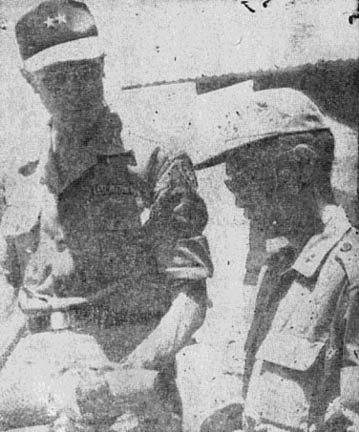 |
CONTRABAND - Major General Fred C. Weyand (l), division commander, and Brigadier General Phan Trong Chinh, commander of the 25th Division, Army of the Republic of Vietnam, examine a Chinese 57mm recoilless rifle shell captured by “Tropic Lightning” soldiers on the joint U.S.-ARVN Operation “Makiki.” |
Page 7 TROPIC LIGHTNING NEWS June 24, 1966
Scroungers Get Last Haul
Fourth Battalion, 9th Infantry, proved that text book techniques are still
effective against the Viet Cong. During Operation “Wahiawa,” a Manchus
reconnaissance platoon trapped three Viet Cong by effectively springing a “stay
behind” ambush.
After a battalion leaves its base area the Viet Cong scavengers enter. The
men of the 4th knew this and decided to try an old trick, leaving a group of men
behind to ambush the scavengers.
A scout section from Lieutenant Charles Scott’s reconnaissance platoon was
chosen to stay, conceal themselves in the area and wait for the Viet Cong to
show up.
Staff Sergeant Oscar E. Smith, scout section leader, placed his men inside
the existing perimeter as the rest of the battalion prepared to depart.
They stationed themselves strategically throughout the area, hiding behind
small bushes and lying in rice paddies. Camouflage was difficult because of the
large open area within the perimeter and the limited amount of natural cover.
The area looked deserted. The scout section planned it that way. If one man
revealed himself, the entire platoon would be placed in danger.
Waiting is always the hardest part of an ambush. The sweat running down the
forehead, the stagnant, stinking water from the rice paddy and crawling insects
all made the waiting seem endless, but still the men didn’t move. Time passed
slowly. An hour went by and still no sign of the Viet Cong.
Suddenly shots began coming from the thicket in front of the platoon. At
first they thought the VC had spotted them, but the rounds were hitting all
around them and not concentrated on any one place or person.
The men held their fire. They were receiving probing fire from the VC to see
if anyone was left in the area.
The Viet Cong, receiving no return fire, decided the area was secure and
eight of them entered the clearing from the heavy thicket. They moved closer
and closer to the ambush site.
When one VC was about 45 feet from Specialist Four Vernon Kunkle’s and PFC
William James’ position they tossed two grenades, killing the Viet Cong that was
directly in front of them.
At the same time, Staff Sergeant William Cunningham and Sergeant Elias
Olivarez each shot and killed one more VC. The other members of the ambush
began firing on the five retreating VC.
When the firing stopped, three Viet Cong were dead and another three were
suspected killed. There were no injuries to the recon platoon.
English-Teaching Job Falls to Suggestor
Suggesting a better way often means executing the suggestion, as 2nd
Lieutenant Tim Rosenheim, of Philadelphia, Pa., learned when he announced he
thought it would be a good idea to teach English to Vietnamese students in Hau
Nghia Province.
Lt. Rosenheim, who became involved in the project shortly after he became
assistant adjutant for Headquarters and Headquarters Company, 2nd Battalion,
27th Infantry, is a unique language instructor in that he speaks no Vietnamese
- outside of the usual pleasantries.
But what he lacks in the native tongue, the lieutenant more than compensates
for in enthusiasm, a fact borne out by his students, who eagerly swarm to his
classes voluntarily.
Teaching in a village meeting hall for an hour and a half weekly, Lt.
Rosenheim wields a simple phrase book to teach conversational English.
He works from self-made lesson plans to offer such dialogues as, ‘Hello. How
are you ?’ ‘I’m fine, thanks. How are you?’
In three weeks, the “Tropic Lightning” lieutenant has brought the villagers
from the ultra-simple “Hello” to answering basic questions. When holding up a
notebook, he can ask, “Is this a pencil?” and hear the reply, “No. That’s a
notebook.”
With the combined enthusiasm of teacher and students, it shouldn’t be long
before about 90 Vietnamese are speaking English comfortably – with a
Philadelphia accent.
‘New-Lifers’ Get Richer From Division Donations
Life in Ben-Vang, a ‘new life’ village located 40 miles northwest of Saigon,
is going to be considerably better since its inhabitants have received food and
clothing from the 25th Infantry Division.
Ben-Vang is a fortified home for refugees who are starting a ‘new life’ in
new surroundings. Helping the newcomers are 2nd Brigade and the Special Forces
Detachment at Kiem Hanh, the district in which Ben-Vang is located.
Approximately 500 villagers turned out during an intermittent light shower to
receive the canned goods, summer-weight clothing, rice and salt donated by
generous contributors from Hawaii.
The chattering of the men, women and children stopped when Captain Nguyen Van
Mach, chief of the Khiem Hanh District, led the joint group to a table set up
for presentation of the gifts. Three Cao Dai priests, dressed in white clothes
and black skull caps, joined the group, and the first recipient was called.
The villagers - men and women, young and old - kept coming to accept their
packages of American clothing: a bag of rice and several cans of food assembled
for distribution by Major Robert C. Gutner, the brigade civil affairs officer.
Sgt. Shaw comes from Petersborough, England, 80 miles north of London, but
now calls Fayetteville, N.C., his home.
Dead Cong Makes Day For PFC
PFC Paul V. Banther, of McDonald, Tenn., a 20-yearold member of Company B,
1st Battalion, 35th Infantry, was the point man on a patrol during Operation
“Paul Revere.”
“About 900 feet from the company command post, we crossed a stream and were
moving up a trail,” he said. “I looked along the trail and saw a VC stand up
from behind a machine gun. There ware two more behind him, running away.
“I turned around and yelled to the others in the platoon.”
“Thinking I had my M-16 on automatic, I kneeled down and began firing. I
only got off about four or five rounds. I didn’t think I had a chance of
hitting any of them because I really couldn’t see them too well; there was high
grass between them and me,” Banther explained.
“Later,” he continued, “an artillery forward observer, who was posted nearby,
told me I had hit one of them.”
“My platoon sergeant came up to me and said, “Don’t worry. We’re going to
make a hero out of you yet!”
This Little Piggy Went to (Viet) Luau
A traditional Hawaiian luau conjures up images of burning tiki torches,
steaming imus (underground oven) and simmering ti leaves. It is the rare luau
that is supervised by a burly Army master sergeant, illuminated by aerial flares
and laced with the sounds of thundering artillery.
But no matter, insists Master Sergeant Levi Haina Jr., a typical Hawaiian
kamaaina (old-timer), for whom no excuse is necessary for an old fashioned
hookilau.
Nonetheless, a good excuse does add legitimacy to it all and the luau that
sprouted at Cu Chi last week was ostensibly a “thank you” party for these who
had helped build the new office building for 25th Military Police Company’s
Criminal investigation Division.
Sergeant Haina, operations sergeant with the Division Provost Marshals
Office, adhered to strict Hawaiian tradition in preparing the kalua pig, the
luau’s main course. The 110-pound pig was packed with hot stones from the imu,
filled with water and buried beneath successive layers of soaked canvas, banana
leaves and dirt. Five hours later, two cooks, stripped to their waists Hawaiian
style (less the lava-lavas), their mouths watering and their backs gleaming with
perspiration, pulled the steaming pig from the ground.
The repast, complete with fresh pineapple, some very unHawaiian baked beans,
tossed salad and French bread, fed 25 division members, who managed to enjoy the
Southeast Asian luau under improvised tiki torches and potted palm trees.
Aloha nuiloa.
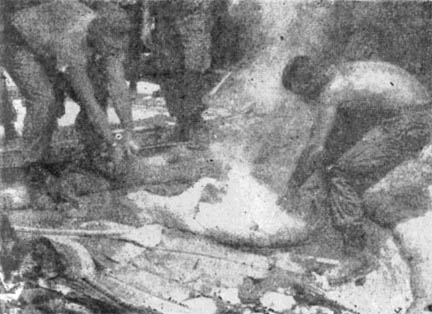 |
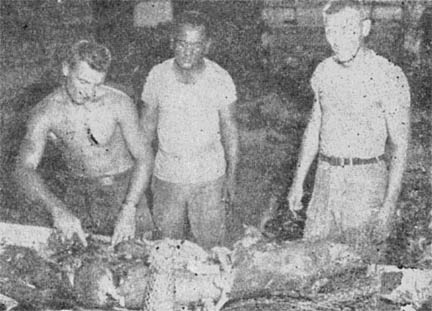 |
| PORKER - Two members of the 25th Military Police Company place the kalua pig in the imu pit, to simmer in its own juices in the ground for five hours. | SCULPTURE - Staff Sergeant William Bradley cuts the kalua pig under the direction of Master Sergeant Levi Haina (center), while Sergeant first Class Jerome P, Eckert observes. (Photo by Pardue) |
Page 8 TROPIC LIGHTNING NEWS June 24, 1966
| Vietnam Communique... A weekly summary of major Army actions in the Republic of Vietnam compiled by
Army News Features from Department of Defense published Official MACV
Communiques. June 9 through June 15, 1966 1st Cavalry Division (Airmobile) - No major actions reported. (On June 14
an element of the division reinforced units of the 101st Airborne Division
engaged in operation HAWTHORNE). |
HEAVILY ARMED VIET CONG WAVES AND SURRENDERS
The experience was similar to driving through a red light and having the
policeman on the corner smile congenially.
The difference was that Sergeants James A. Meisner, of Phoenix, Ariz., and
John C. Alton, of Vincennes, Ind., were on patrol during 3rd Brigade’s Operation
“Paul Revere.”
Part of a reinforced squad patrol was going to set up a night ambush.
Meisner said, “We had just gotten outside the perimeter and were getting the
patrol set up when Sergeant Alton and I saw a North Vietnamese Army soldier
sitting in a hammock.”
“We motioned for him to get out of the hammock and then signaled for him to
put up his hands,” Meisner continued.
“When we motioned for him to raise his hands,” Alton said, still shaking his
head in disbelief, “he waved back at us !”
His face didn’t show any fright, but his knees were knocking like dry bones,”
Meisner observed. “It looked as if his legs were doing the watusi but his body
wouldn’t cooperate.”
When the captive stopped waving, the two noncommissioned officers searched
him. He was armed with four hand grenades, but there was no sign of a rifle.
He offered no resistance.
“After blindfolding him, we sent him back to the perimeter with two other men
in our patrol,” Meisner said. “He was turned over to the perimeter guards
there.”
It was found during interrogation that the NVA soldier had been lost from his
unit for four days and had not eaten anything in that time.
He told the interrogators that he wanted to give himself up but was afraid to
approach the perimeter because he thought he would be shot.
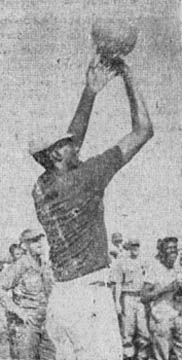 |
STRETCH - Fire mission! Leroy Ellis, of the Los Angeles Lakers, shoots a two-pointer as members of Headquarters Battery, Division Artillery, look on. Ellis, Darrell Imhoff and Rudy LaRusso recently toured the “Tropic Lightning” base camp at Cu Chi. (Photo by Pardue) |
NBA Giants Score at Cu Chi
Ellis Wants To Know “What’s Happening?”
When three long, tall National Basketball Association players walked into
the mess hall of Battery C, 3rd Battalion, 13th Artillery, there was a surprised
silence.
Looking over the silent audience of 20 to 30 soldiers, Leroy Ellis, a
towering six-foot, ten-inch center, spread his big arms wide and said, “What’s
happening, fellows? Say something.”
The men laughed and the ice broke as the three NBA stars continued their
one-day visit to Cu Chi.
Ellis was joined by center Darrell Imhoff and forward Rudy LaRusso, all stars
for the Los Angeles Lakers.
Soon each of the players was sitting down, casually talking with the men
about the war, basketball and girls.
“Hey,” Ellis announced. “I want to shoot one of those cannons (referring to
the 155mm self-propelled howitzers.) “I want to get a few Charlies.”
The three soon moved on to Headquarters, Division Artillery, where Ellis was
handed a basketball and the three were led to the battery basketball court to
take a few shots in weather they admittedly had never before played in.
The aces went to the court and the troops followed. Although they claimed
the basket was an old sewer rim and the court could have passed as a rice paddy,
they nevertheless found their range and started dropping shots through.
Ellis, who had a sure way of not missing, found the side he wanted, dribbled
three times, passed the bucket and then went up, stuffing the ball through the
net, two-handed and backwards.
At Battery C, 7th Battalion, 11th Artillery, where things were relatively
quiet, Imhoff, LaRusso and Ellis each got one shot on the 105mm howitzers.
During their tour of the division, sponsored by the USO, the three discussed
sports and the war.
On basketball. (Imhoff): “The (Boston) Celtics are a tough team to beat.
They have pride. After all, they’ve won nine championships in the last 10
years. But they are getting older.”
On the war (LaRusso): “Everywhere we’ve been the morale of the men has been
good. They are counting the days, which I think is natural. But they know they
have a job to do and they are doing it.”
On sports in general (Ellis): “The men here are surprisingly up to date on
their sports. Naturally, they don’t ask us too many questions about baseball,
but they know what’s going on.”
With time pressing, they moved out on a fast break, catching a helicopter to
Saigon, where they would visit another court tomorrow.
MEDCAP TEAM SAVES VILLAGE FROM SMALLPOX
What could have been a disastrous smallpox epidemic in the little village of
Hau Hoa was averted June 16 by a division Medical Civic Action Program Team.
Captain Donald G. Winningham, Seattle, Wash., and medics from the 1st
Battalion, 27th Infantry, treated the Hau Hoa villagers while the battalion was
on Operation “Santa Fe.”
During the visit, the doctor discovered that a 50-year-old woman living next
door had an advanced case of smallpox. Although the woman had survived the peak
of the disease, Capt. Winningham realized that the 200 residents of Hau Hoa were
in danger of contracting smallpox.
On the afternoon of the discovery, enough smallpox vaccine to inoculate the
entire population was flown in. Vietnamese national policemen went from house
to house with a truck and a loudspeaker and told the villagers the necessity of
being vaccinated. I
In two hours, battalion medics administered 156 doss of the serum.
Top Warehouses
A combination of ingenuity and necessity have produced some of the finest
pre-fabricated warehouses this side of the Hawaiian Islands.
The warehouses, belonging to the 725th Maintenance Battalion, each
accommodate 600 of the 15,000 line items of technical supply that the battalion
handles.
The rest are either stored outdoors in weatherproof containers or in one of
11 vans.
The warehouses are made of boxes on pallets stacked three high with the open
ends pointing into a central aisle, ten stacks of three on either side. The
backs of the boxes, covered with tarpaper, form the building’s outer wall.
Storage bins from the old warehouses in Hawaii were welded into A-frames and
placed on top to support a 20-by-40-foot tarpaulin, which forms the roof.
Thanks to:
The 25th Infantry Division Museum for providing the volume of 1966 Tropic
Lightning News,
Ron Leonard, 25th Aviation Battalion for finding and mailing them,
Kirk Ramsey, 2nd Bn., 14th Inf. for creating this page.
This page last modified 10-15-2006
©2006 25th Infantry Division Association. All rights reserved.